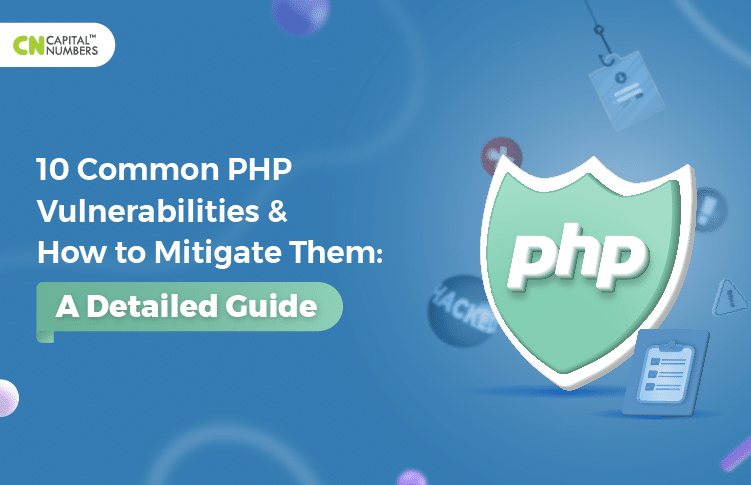10 Common PHP Vulnerabilities & How to Mitigate Them: A Detailed Guide
Table of Contents
With its dynamic nature, colossal credibility, and consistent popularity in tech and retail, PHP powers around 80% of websites. Its versatility and ease of use have contributed to its popularity among developers. However, like any technology, PHP is not immune to vulnerabilities that expose applications and their users to potential risks.
According to popular research, PHP has the maximum security flaws, making it an attractive target for cybercriminals. The language has application-level vulnerabilities that make it prone to various attacks. So, security in PHP web applications is a common concern among CEOs and CTOs, often preventing them from choosing this pragmatic language for web application development. Are you also in the same dilemma?
Well, don’t be. There are PHP vulnerabilities and effective ways to mitigate these. Here we will discuss all these in detail. Read on.
Why is PHP prone to attacks?
Here are the reasons why PHP is vulnerable to continuous attacks and security threats. Let’s dive in –
Ⅰ. Wide adoption and prevalence
The popularity and widespread usage of PHP make it an attractive target for attackers due to its many PHP-powered websites and applications.
Ⅱ. Historical security concerns
PHP has had some security concerns, primarily related to default configurations, deprecated functions, and outdated code in legacy applications.
Ⅲ. Weak input validation
Insufficient validation of user input in PHP can lead to vulnerabilities such as injection attacks (e.g., SQL injection, OS command injection) and cross-site scripting (XSS) vulnerabilities.
Ⅳ. Dynamic typing and loose data handling
PHP’s dynamic typing and loose data handling can introduce security risks if not handled properly, allowing attackers to execute arbitrary code or gain unauthorized access.
Ⅴ. Complexity and rapid development
While PHP allows for rapid development, the pressure to deliver projects quickly can result in developers overlooking security best practices, leaving applications more susceptible to attacks.
Common PHP vulnerabilities and how to fix these?
Whether you hire PHP developers or rely on your in-house talents to develop an app or website, knowing about the common PHP vulnerabilities is a must. To help you, here we have discussed these in detail –
1. Cross-Site Scripting (XSS) Attack
A common PHP security vulnerability happens when an attacker injects a malicious JavaScript or HTML code into your website to steal user cookies and passwords or gain administrative-level access.
How to fix this?
- Implement strict input validation and sanitization techniques to ensure user-provided data is free from malicious scripts.
- Always encode output data to prevent interpreted HTML or JavaScript code from executing in the browser. Utilize appropriate encoding functions for different contexts.
- Implement a Content Security Policy that defines the allowed sources of content, including scripts, stylesheets, and images, to restrict the execution of unauthorized scripts on web pages.
- Set the “HttpOnly” flag on cookies to prevent client-side scripts from accessing sensitive cookie data.
- Implement context-aware output filtering based on the specific output context (e.g., HTML, JavaScript, URL). Use security libraries or frameworks with built-in output filtering mechanisms to automatically handle context-specific encoding.
- Conduct regular security audits and perform vulnerability scanning and penetration testing to identify and address any potential XSS vulnerabilities in your PHP application.
2. Cross-Site Request Forgery (CSRF)
CSRF involves tricking a user’s browser into clicking on a malicious link that can steal session information, invisibly override access, or automatically send legitimate-looking commands to the server on a trusted website where the victim is authenticated. Attackers exploit the trust relationship to perform unauthorized actions on your behalf without your consent.
How to fix it?
To address the PHP vulnerability of CSRF, it is vital to include a unique CSRF token in all forms and AJAX requests
- Verify the CSRF token on the server side before processing the request.
- Use techniques like SameSite cookies and anti-CSRF libraries to provide additional protection against CSRF attacks.
3. SQL Injection
SQL injection is a type of cyber attack that targets databases and occurs when an attacker inserts malicious SQL code into a database query through an application’s input fields. The goal of an SQL injection attack is to manipulate the structure and behavior of the database query, allowing the attacker to access, modify, delete data, or even execute arbitrary commands.
How to fix this?
- Use parameterized queries or prepared statements to separate user input from SQL code.
- Implement input validation and sanitization on the server side.
- Apply the principle of least privilege by granting minimal database privileges to application accounts.
- Minimize dynamic SQL generation and avoid constructing queries with user-supplied input.
- Train developers in secure coding practices and regularly review code for vulnerabilities.
- Consider using a Web Application Firewall (WAF) to detect and block SQL injection attempts.
- Keep software updated with the latest security patches and updates.
- Conduct security testing, including penetration testing and code reviews, to identify and address vulnerabilities.
4. Remote Code Execution
Remote Code Execution (RCE) is a PHP vulnerability where attackers can execute their code remotely on a target system. It occurs when PHP code lacks proper security measures, allowing unauthorized code execution. RCE vulnerabilities can lead to unauthorized access, data manipulation, and system control.
How to fix it?
To mitigate RCE vulnerabilities, it is crucial to follow secure coding practices when developing PHP applications. This includes:
- You should avoid using dangerous functions. Functions like eval() or system() should be used cautiously or avoided altogether, as they can introduce potential security risks.
- You should always validate and sanitize user input before using it in PHP code. It helps prevent malicious code injection.
- When interacting with databases, use parameterized queries or prepared statements to prevent SQL injection attacks.
- Regularly update PHP and its associated libraries to benefit from security patches and bug fixes.
- Restrict access permissions on the server to prevent unauthorized execution of code.
- Employ a web application firewall (WAF). A WAF can help detect and block attempts to exploit RCE vulnerabilities.
5. File Inclusion Vulnerabilities
File inclusion vulnerability in PHP is a security weakness where attackers can include and execute arbitrary files on a web server. It can be either local or remote. Local File Inclusion (LFI) allows accessing files on the same server, while Remote File Inclusion (RFI) involves including files hosted on external servers. These vulnerabilities occur due to inadequate input validation.
How to fix it?
To mitigate this, it is essential to follow secure coding practices, including:
- Avoid using user-supplied input directly in file inclusion functions. Sanitize and validate user input before using it.
- Whitelist allowed file names or locations rather than relying on input filtering.
- Use absolute file paths instead of relative paths to ensure that only intended files are included.
- Avoid using user-controlled input as part of the file path, especially when using include() or require() functions.
- Limit file inclusion to specific directories and avoid using wildcard characters.
- Keep PHP and its associated libraries up to date to benefit from security patches and bug fixes.
6. Session Hijacking
In session hijacking, an attacker steals a user’s session ID and accesses everything that happened during that session. For example, if you use a particular session to log in to a website or authenticate a user, attackers can use that session to sign in and exploit your website.
How to fix it?
In session hijacking, an attacker steals a user’s session ID and accesses everything that happened during that session. For example, if you use a particular session to log in to a website or authenticate a user, attackers can use that session to sign in and exploit your website.
To mitigate this, you can take the following measures –
- Employ secure protocols like HTTPS to encrypt the communication between the user’s browser and the server, preventing session IDs from being intercepted.
- Generate new session IDs after a user logs in, logs out, or performs sensitive operations to minimize the window of opportunity for session hijacking.
- Set a reasonable expiration time for sessions so that inactive sessions are automatically terminated.
- Ensure that session data is stored securely on the server side and not accessible to unauthorized users.
- Utilize PHP functions specifically designed for secure session management, such as session_regenerate_id() and session_set_cookie_params().
7. Insecure Direct Object References (IDOR)
An IDOR PHP vulnerability occurs when an app exposes internal object references directly in the URL or parameters. Attackers can manipulate these references to access unauthorized resources or act without permission.
How to fix it?
To mitigate IDOR vulnerabilities in PHP applications, it is crucial to follow secure coding practices:
- Ensure that access to objects or resources is validated and authorized on the server side, considering the user’s identity and permissions.
- Avoid using sequential numbers, predictable identifiers, or other direct references that can be easily manipulated. Instead, use unique and randomized references that are not easily guessable.
- Define and enforce fine-grained access control policies based on user roles and permissions.
- Ensure that session IDs or tokens are properly managed and associated with the authenticated user, preventing unauthorized access to other users’ data.
- Perform security assessments, including penetration testing and code reviews, to identify and address potential IDOR vulnerabilities.
8. Invalidated File Uploads
Invalidated file uploads refer to a vulnerability where an app fails to validate and sanitize user-uploaded files properly. It allows attackers to upload and execute malicious files on the server or enable them to overwrite critical files, potentially compromising the system’s security.
How to fix it?
To mitigate invalidated file upload vulnerabilities, you should consider these practices –
- Check the file’s extension and verify it matches the expected file type. Also, consider using file signature analysis to validate the file’s content.
- Apply server-side checks to verify the file’s integrity, size, and other relevant attributes. Reject or quarantine files that fail to meet the specified criteria.
- Store uploaded files outside the web root directory to prevent direct access and execution by the server. Only serve files through controlled, secure mechanisms.
- Limit access permissions on uploaded files to prevent unauthorized execution or tampering.
- Use antivirus or malware scanning tools to detect and block malicious files.
- Keep file upload libraries and modules up to date to benefit from security patches and bug fixes.
9. Code Injection
Code injection refers to a vulnerability where an attacker is able to inject and execute arbitrary PHP code within a PHP application. This vulnerability occurs when user-supplied data is not properly validated or sanitized before being incorporated into PHP code execution. Common types of code injection in PHP include PHP eval injection, command injection, and PHP object injection.
How to fix it?
To mitigate the vulnerabilities in PHP, you should follow these practices –
- Always validate and sanitize user-supplied input before using it in dynamic PHP code execution.
- Minimize or avoid using functions like eval() or preg_replace() that can execute arbitrary code based on user input.
- When interacting with databases, use prepared statements or parameterized queries to prevent SQL injection attacks, a code injection type.
- Configure PHP settings to enable security features like magic quotes and disable dangerous functions if not required.
- Keep PHP and its associated libraries up to date to benefit from security patches and bug fixes.
10. Insecure Cryptography
Using weak encryption, poor key management practices or flawed implementation of cryptographic functions in PHP can expose a PHP vulnerability. Such vulnerabilities can undermine the security of sensitive data, including passwords or session tokens, underscoring the importance of employing robust encryption protocols and following the best practices for cryptographic operations.
How to fix it?
To mitigate these vulnerabilities, you can consider the following practices –
- Use strong encryption algorithms and securing hashing functions.
- Store passwords and sensitive information as hashed values with a unique salt.
- Implement secure key management practices and ensure the confidentiality and integrity of cryptographic keys.
How to improve the overall PHP security?
Here are the best ways to improve the overall security of PHP applications –
- Keep PHP and dependencies updated: Regularly update PHP, libraries, and frameworks to the latest versions to benefit from security patches and bug fixes.
- Implement secure coding practices: Follow secure coding guidelines, such as input validation, output encoding, and proper handling of user data, to prevent vulnerabilities.
- Use strong authentication: Implement strong password hashing algorithms and consider implementing multi-factor authentication (MFA) for added security.
- Protect against XSS attacks: Sanitize and validate user input to prevent cross-site scripting (XSS) vulnerabilities. Use output encoding functions or security libraries to display user-generated content safely.
- Prevent injection attacks: Use prepared statements or parameterized queries to prevent SQL injection attacks. Validate and sanitize user input to avoid command injection and other injection vulnerabilities.
- Secure session management: Generate secure session IDs, store them securely, and implement session timeout and regeneration to mitigate session hijacking and fixation attacks.
- Enable secure communication: Use HTTPS (SSL/TLS) to encrypt data transmitted between the server and clients, protecting sensitive information from eavesdropping and tampering.
By implementing these best practices, you can significantly enhance the security of your PHP applications and protect them from common vulnerabilities.
Also Read: PHP or Laravel: What to Choose for Your Web Application Development Project
Bottom Line
PHP offers immense flexibility and power for web development, but it’s essential to address common vulnerabilities to ensure the security of your apps. By understanding and mitigating the risks associated with the vulnerabilities, you can significantly enhance the security posture of your PHP apps.
Update your PHP version regularly, follow secure coding practices, implement proper input validation and output encoding, and leverage security libraries and frameworks to fortify your PHP apps against malicious attacks. Adopting a proactive and vigilant approach, you can safeguard your PHP applications and protect sensitive data from potential threats.
At Capital Numbers, a leading PHP development company, we focus on security and assist you in building robust apps and websites as per your needs. Want to get our services? Book a call today!















